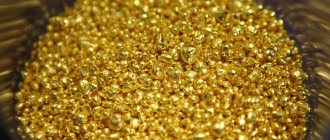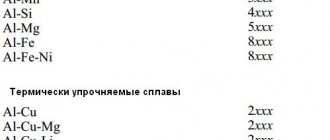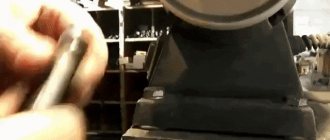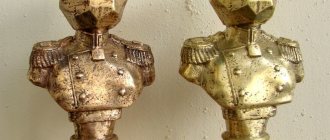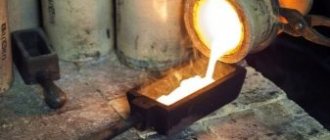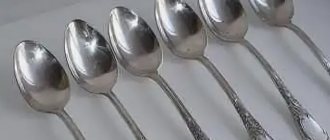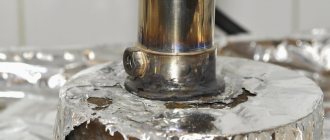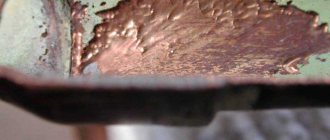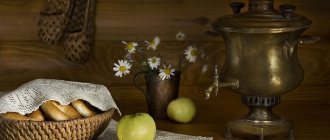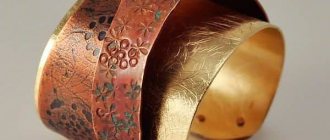To accurately distinguish brass from copper at home, it is enough to know the composition and some characteristics of these materials.
Copper is a pure metal, and its alloy with zinc is called brass. Due to their different compositions, these materials have several important differences:
- Color . Copper has a reddish tint, while brass is yellow.
- Weight . Copper is slightly heavier than brass.
- Hardness _ Copper is softer, brass is harder.
- Density _ For copper it is 8920 kg/m3, for brass it is from 8300 to 8700 kg/m3.
It should be noted right away that it is not possible to recognize at home that what we have in front of us is a metal or its alloy using a magnet. Both materials are not attracted to them.
However, there are several ways to distinguish copper from brass without resorting to spectral analysis in the laboratory. All of them are described below - from the simplest to the most complex.
Determination by color
The easiest way to determine whether a product is copper or brass is by its color. For accuracy, it is recommended to thoroughly clean the metal surface from dirt and oxide film. As mentioned earlier, copper has a reddish tint, sometimes brownish or pink.
If the product under study has a yellowish color, reminiscent of gold, then this is most likely brass. And the more pronounced the yellowness, the greater the proportion of zinc in the alloy.
You can determine the metal by color by comparison with a known product. In everyday life, as a copper sample, you can use an electrical wire, cleared of insulation and protective varnish. Brass can be seen on the plugs of electrical appliances - their pins are made from this alloy.
Historical reference
Copper is one of the most important elements of antiquity. Copper, gold , silver and tin were the first metals that humanity recognized in its historical development. Because copper is easily processed, it was used by ancient cultures more than 10,000 years ago. The time of widespread use of copper began in the 5th millennium BC. to the 3rd millennium BC
However, in its pure form, copper turned out to be relatively soft for the production of weapons and tools. Therefore, ancient people, through experiments, adding pieces of lead and tin to molten copper, obtained bronze. It is a much harder material than unalloyed copper. Bronze has been used by humanity for over 5,000 years. This alloy gave its name to an entire historical era.
In alchemy, copper was associated with Venus (femininity). Of course, not least because the first mirrors used by women were made of this metal.
Determination using chemistry
This method is one of the simplest and most accessible, and at the same time quite accurate. To determine the composition of the metal, you will need a solution of hydrochloric acid. Such liquids are often used to clean contacts when soldering in radio electronics. Accordingly, acid can be bought at any radio store. And it's inexpensive.
Without going into details and without resorting to chemical formulas, the essence of the test is as follows. A few drops of acid must be applied to the surface of the metal being tested. If it is copper, then it will simply be cleaned and acquire its natural reddish or pinkish tint. If we have brass in front of us, then a chemical reaction will take place on its surface with the release of a white substance - zinc oxide.
Dissolution in ammonia
The process often occurs by passing NH3 in gaseous form over hot metal. The result is the dissolution of copper in ammonia, the release of Cu3N. This compound is called monovalent nitride.
Its salts are exposed to ammonia solution. The addition of such a reagent to copper chloride leads to the formation of a precipitate in the form of hydroxide:
CuCl2 + NH3 + NH3 + 2H2O → 2NH4Cl + Cu(OH)2↓.
Excess ammonia promotes the formation of a complex type compound that is dark blue in color:
Cu(OH)2↓+ 4NH3 → [Cu(NH3)4] (OH)2.
This process is used to determine cupric ions.
Determination by density
This is the most complex method described, and rarely anyone adopts it. However, it is quite effective and accurate, and most importantly, it can be performed at home.
The bottom line is that first the exact mass of the product under study is determined, and then its volume. Knowing the density of copper and brass, using the identified parameters it will be possible to determine the composition of the material. If an object has a complex shape, then its volume can be calculated by immersing it in a container of water. To determine weight, it is better to use scales with high accuracy.
- Non-ferrous metals
- Copper
- Brass
- Aluminum
- Lead
- battery
- Scrap electric motors
- Black metals
- Stainless steel
- Scrap steel
- Cast iron
- 3A size
What is copper and brass
Copper is a non-ferrous metal. Its color is reddish-pink, it is pliable when working, soft and malleable. It has high thermal and electrical conductivity, so copper is often used to produce:
- parts of electrical appliances;
- cables;
- radiators.
Copper is not hardened because it becomes hard even after cold forging. It tends to become covered with patina - a green coating that occurs when the ambient humidity is high.
To increase strength, improve a number of other indicators and reduce the cost of the material, impurities are added and an alloy is obtained.
One such alloy is brass .
In the classic version it contains a third of zinc.
Brass is golden yellow, stronger and harder. It does not oxidize so intensively , and is not so plastic.
Sometimes, depending on the purpose of the alloy, they add:
- tin;
- silicon;
- lead;
- manganese.
How to determine copper wire or aluminum
Advantages of copper cable. Why do many people prefer cables with copper filling?
Copper cable has better conductivity compared to aluminum. With the same cross-sectional area of the cable core, copper can withstand loads significantly greater than aluminum.
For example, with a cross-sectional area of 10 mm2, an aluminum conductor can withstand an electric current of up to 50A, and a copper conductor of the same cross-section can withstand a current of up to 70A.
That is, if it is necessary to replace an aluminum cable along a ready-made main line and the thickness of the cable is limited, and the expected load has increased, then laying a copper cable instead of aluminum will allow, with the same cable dimensions, to increase the permissible load.
Copper cable has better conductivity compared to aluminum. With the same cross-sectional area of the cable core, copper can withstand loads significantly greater than aluminum.
For example, with a cross-sectional area of 10 mm2, an aluminum conductor can withstand an electric current of up to 50A, and a copper conductor of the same cross-section can withstand a current of up to 70A.
That is, if it is necessary to replace an aluminum cable along a ready-made main line and the thickness of the cable is limited, and the expected load has increased, then laying a copper cable instead of aluminum will allow, with the same cable dimensions, to increase the permissible load.
Copper cable has greater chemical resistance compared to aluminum. Copper is a noble (inert) metal and does not react chemically with most substances. And aluminum is exposed to chemical attack, as a result of which it is destroyed.
Copper cable has greater mechanical strength compared to aluminum. This can be observed at the connection points of aluminum cables in home wiring. In the area of the terminals, the aluminum core is always very crushed and often destroyed, which never happens with a copper core.
Advantages of aluminum cable.
Aluminum cable is suitable for temporary wiring. Due to its low cost (low cost is at least three times cheaper than a copper cable), you can save a lot on this type of cable.
First of all, it is, of course, lightweight. This is an indisputable advantage: it is more convenient to roll out a coil or coil with a lightweight cable, and when it comes to installing power lines, then lightness becomes the most valuable quality.
But in addition to the advantages, there are also disadvantages of aluminum cable.
Aluminum as a conductor, compared to copper, has a higher electrical resistivity - 0.0271 Ohm x sq. mm/m versus 0.0175 Ohm x sq. Mmm. The difference is almost double!
It is the high resistivity that negates the advantage of aluminum being lightweight. It turns out that in order to ensure the same conductivity, we will have to take a much more powerful, and therefore heavier, aluminum conductor than if we used copper.
Everyone knows very well that aluminum is a corrosion-resistant metal. But from the chemistry course we know that this is not entirely true. Aluminum itself oxidizes in air very quickly. But the resulting thin film of oxide protects it from further chemical destruction.
But the protective film already has slightly different properties than the metal itself. In particular, it is no longer such a good conductor. This means that increased contact resistance may form at the point of electrical contact with the aluminum oxide film. And this leads to heating of the contact, which in turn leads to an even greater increase in electrical resistance.
This is such a vicious circle. The result is melted contacts, an open circuit or unreliable power supply.
You have to look for the problematic contact, tighten it, or change the clamps, and aluminum subjected to prolonged heating, which already does not have much ductility, can break off from any careless movement. Then a cable replacement will be required, which is not always technologically possible.
However, the use of a particular cable also depends on the purpose for which it is used. Each electrical appliance has its own power, which will directly determine the cross-section of the cable, and therefore its filling.
In the cable abbreviation, to denote an aluminum core, the letter A is at the beginning. That is, A is added to the already familiar rulers, and the result is AVVG, AVVGng, AVVGng(A)-LS, AVBbShv, AVBShv, respectively.
If you have decided on the type of cable that is right for you, be sure to check the quality of the product before making a purchase. A cable made of any metal must be stored in appropriate conditions and have all the necessary technical documentation.
Advantages of aluminum wiring
The fact that aluminum, not being a standard for electrical wiring, is preferable in its quality in residential buildings is due precisely to its advantages over other metals.
Biological effect
Copper is a component of blue hemocyanin, which is used by many molluscs and arthropods as a blood dye to transport oxygen. Copper is also a vital trace element in higher organisms and is a component of many enzymes.
The daily requirement of copper for an adult is about 2 milligrams.
The copper depot in the human body is located in the liver. Excess copper is excreted through the digestive system along with bile. Compared to many other heavy metals, an excess of copper does not cause significant harm to the body. A person can eat 0.04 grams of copper per day without harming their health. Copper is mainly found in chocolate, liver, cereals, vegetables and nuts.
Copper deficiency is rarely diagnosed in people. It is mainly observed in chronic diarrhea, in premature babies, and during prolonged fasting. Consuming high doses of zinc, iron , or molybdenum can reduce the amount of copper in the body. In its free (not bound to protein) form, copper has pronounced antibacterial properties. Pure silver has the same qualities.
Copper sulfate ( copper sulfate ) is a strong emetic and is therefore used to treat many intoxication diseases at the acute stage.
How to distinguish brass from bronze: proven methods?
Copper alloys have a similar chemical composition, so the external characteristics of bronze and brass are the same. This creates difficulties when it comes to distinguishing between metals. The main reason for the difficulty in identifying a specific alloy is the large number of grades and modifications of compounds.
Color often does not immediately reveal the type of alloy, so other ways to distinguish between brass and bronze are needed. Typically, owners need to determine the alloy when selling scrap to the secondary market. Our company accepts brass shavings and bronze scrap metal on favorable terms.
We will evaluate the scrap free of charge to accurately identify the composition and grade of the metal, as well as maximum cash payments to customers.
Differences in the price of bronze and brass scrap metal
Our prices for bronze reception
Type of bronzePrice per kg, rub.
| mix, pieces | 240-260 |
Our prices for receiving brass
Type of brassPrice per kg, rub.
| mix, plumbing | 190-215 |
| sections, rolled pieces | 200-220 |
Methods for visually identifying an alloy
Brass is made using an alloying component - zinc or tin. Their content is in the range of 4-45%. Bronze is a multicomponent alloy, including a large number of non-metallic components.
The alloying element of bronze alloys can be several substances at once: magnesium, aluminum, silicon, beryllium or manganese. In both alloys, the amount of copper is limited to 60-90%, so it is difficult to distinguish between bronze and brass externally.
Based on external properties, it is worth noting the following characteristics of specific alloys:
- Bronze. A number of grades of this metal contain a large amount of lead, which gives the alloy white-silver shades. With the maximum amount of copper present (about 90%), bronze is similar to copper, having reddish-brown hues.
- Brass. zinc, tin or nickel almost always contribute to the formation of a yellow-golden alloy. Brass compositions are closest in color to pure gold. However, such shades are obtained only if GOST is observed in production.
When complying with regulations, specific brands of bronze and brass can be easily identified by external indicators. However, a number of bronze compositions also have a golden color, which makes it difficult to visually identify the alloy.
How to distinguish bronze from brass using a magnet?
This method will not provide accurate information. However, according to physical laws, not all metals have magnetic properties. In brass and bronze, only iron and nickel are attracted by a magnet. These metals are present mainly in bronze alloys of the BrAZH, BrAZHN and similar brands.
However, the percentage of iron and nickel in the composition is quite small (about 7-11%), so the experiment can only be carried out using a powerful magnet. In brass, the volume of metals with magnetic properties is only 1-3%.
This is why bronze is more easily attracted to a magnet, but it is difficult to get an exact answer, and the method is not suitable for all brands of alloys.
Detection of brass and bronze by heat treatment
If you have equipment or instruments capable of producing temperatures in the range of 600-650oC, you can try to determine the alloy by heating the metals. The method is applicable to brass because it contains zinc. When exposed to this temperature, zinc undergoes oxidation.
As a result of the process, oxide (an ash-colored coating) is formed on the surface of the brass product. Also, the brass alloy itself will become more ductile, so it will not break under heavy loads, but will simply bend. Bronze at temperatures up to 650oC will simply heat up without changing its physical properties.
The method is also applicable only for brass alloys in which the alloying component is zinc, so it is easy to make a mistake if it is not present in the composition.
Methods for chemical determination of alloys
Chemistry is a fairly effective way to identify brass and bronze. However, accurate results can only be obtained by reactions that destroy the metal, which will negatively affect the product. The chemical method includes the following steps:
- chips are removed from the copper alloy (so as not to damage the entire metal);
- mix a solution of nitric acid and water (in a ratio of 1:1);
- Next, you should place the chips in an acidic reagent;
- the solution is heated to boiling point after the chips are dissolved;
- The boiling temperature is maintained over low heat for half an hour.
If the shavings were brass, the solution in the container will remain transparent. When bronze dissolves, a tin precipitate (white) precipitates. Taking this into account, the method only works for bronze containing tin.
Spectral analysis is the only method with a guaranteed result
As described above, it is difficult to accurately determine the type of alloy using available methods. Only modern equipment can help identify bronze or brass with a 100% guarantee.
Spectral analysis is used to determine the composition. It is carried out in our scrap metal purchasing company. We provide an accurate and free metal assessment prior to your appointment.
The price for bronze or brass shavings is indicated in the price list on the website.
